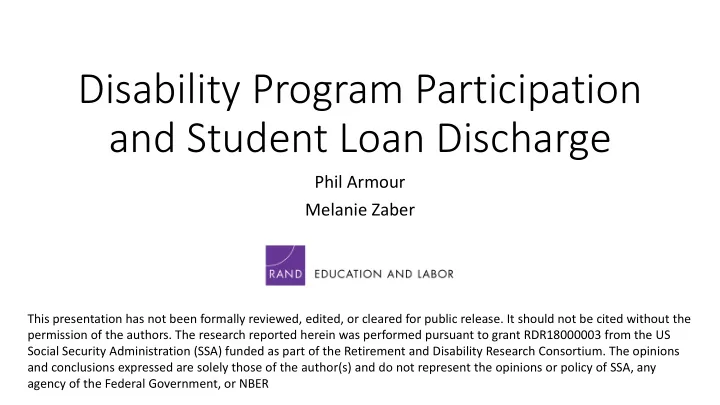

Disability Program Participation and Student Loan Discharge Phil Armour Melanie Zaber This presentation has not been formally reviewed, edited, or cleared for public release. It should not be cited without the permission of the authors. The research reported herein was performed pursuant to grant RDR18000003 from the US Social Security Administration (SSA) funded as part of the Retirement and Disability Research Consortium. The opinions and conclusions expressed are solely those of the author(s) and do not represent the opinions or policy of SSA, any agency of the Federal Government, or NBER
• Department of Education allows for Total and Permanent Disability Discharge (TPDD) of Federal Student Loans • July 2013: Department of Education added SSDI/SSI receipt as a category for TPDD • Did this increase applications to SSDI and/or SSI?
Yes! • But why does it matter? • But eligibility limited to those with determination: “medical improvement not expected” (~25% of beneficiaries) • Existing TPDD category: physician certifying a disabling condition lasting at least 5 years (most common route for TPDD, even now) • Beyond specific policy evaluation, broader implications for SSDI/SSI: • Programs don’t exist in isolation • Better understanding of the pressures on the “marginal applicant” • Saliency matters
So, What is TPDD? • Previously, TPDD allowed through: 1. 100% rating from VA (or Individual Unemployability), or 2. Physician certifies a physical/mental impairment preventing SGA for at least 60 months/result in death • July 2013 Addition: Receiving SSDI/SSI, if medical improvement is not expected • Apply for discharge when applying for SSDI/SSI (loans suspended). Discharge confirmed after 3 year monitoring period once SSDI/SSI and TPDD application accepted; can’t earn above poverty line or take out new federal student loans
Why Is TPDD Attractive? Student loans: Fastest-growing type of household debt
Student Loans, by the Numbers • 45 million have outstanding student loan debt • $1.56 trillion in total debt (Forbes, 2019) • 1 in 10 student loan borrowers is more than 90 days delinquent (Bloomberg, 2018) • Only 25% of borrowers in lowest income quintile neighborhoods are reducing their balances (NY Fed 2017)
Google Searches for “TPD discharge” July 2013 Source: Google Trends
SSDI Applicants as % of 18-65 Population, 2010 (Mean: 1.02%) Source: Authors’ calculations from Form 831-generated statistics.
Percentage with any student loan debt (Mean: 14.1%) Among individuals with a credit bureau record
Difference-in-Differences Study Design • Pre vs. post July 2013 change, by student loan indebtedness • Use prevalence of any student debt, not amount of student debt • Assumption: SSDI application trends would otherwise be parallel across student loan indebtedness in the absence of TPDD change • Reporting SSDI results here; similar findings for SSI
County-Level Approach (2000-2016) • Treatment: % of population with any student loans • Credit Bureau data • Outcome: Per-capita % or log of SSDI applications • SSA-provided • Rich array of county-level socio-demographics; many specifications with fixed effects for year, state, Commuter Zone, county trends
Recent Decline in SSDI Applications Raw SSDI Application Rate of Counties in Lowest Quintile of Student Debt Prevalence
Counties with Higher Student Debt See Increase in SSDI Applications after 2013 Raw SSDI Application Rate Relative to Lowest Quintile of Student Debt Prevalence Counties
Increase is Statistically Significant and Robust SSDI Rate of: Application Award Denial (1) (2) (3) Post X Student Debt 0.0101*** 0.00423*** 0.00584*** (0.00121) (0.000574) (0.000867) Controls Yes Yes Yes Fixed Effects Year, State Year, State Year, State Observations 47,334 47,317 47,310 R-squared 0.704 0.479 0.702 Two-way standard errors (county by year); rate is per person 18-65 *** p<0.01, ** p<0.05, * p<0.1
Interpreting the Size of the Estimate • For a county with the mean fraction with student debt (14%) vs. a county with no student debt, after July 2013: • 1.4 additional SSDI applicants (and 0.6 awards) per 1,000 residents, about a 14% increase in application rates • Robust to alternative specification of student debt • Quintiles vs. continuous variable: Effect driven by top two quintiles • Specifications using fraction with “any college” attainment
Study Design, Part 2: Individuals • 2014 Survey of Income and Program Participation, matched to SSA Form 831 Records • SSDI Applications from 2010 to 2016 • Treatment: Indicator for any student loans (2014 SIPP) • Outcome: Applied for SSDI for 1 st time in current quarter • Discrete-Hazard Approach: follow working age adults at-risk of SSDI application, drop from sample after observing application (~3,000 apps observed) • Rich array of sociodemographic controls and time fixed effects
Overall Treatment Odds Ratio: 1.46*** Logit Odds Ratio 2010 X Student Debt 0.363 1.44 SE (0.227) 2011 X Student Debt 0.146 1.16 SE (0.243) 2014 X Student Debt 0.500** 1.65 SE (0.236) 2015 X Student Debt 0.641*** 1.90 SE (0.238) 2016 X Student Debt 0.397 1.49 SE (0.252) Controls Yes, FEs N 239,214 Pre-2013 Average 0.013
Variation in Treatment Effect • Similar effects for logit and OLS/WLS • Falsification test: no effect by credit card/other debt • By education: those with College+ • By age: 30-39, 50+ have strongest effect • No significant differences by race/ethnicity/gender • Constructing a comparable estimate: an area with 14% of population with student loans would have 0.9 more SSDI applicants/1,000 people • Smaller than county-level analysis, but not statistically significantly different
Conclusions • Student debt loads are large; extending discharge to include SSDI/SSI eligibility lead to increased applications to these programs despite existing medical eligibility standard • About as likely as average applicant to be accepted; driven by individuals in 30s or 50s • Going forward: examine how strength of labor market interacts with student debt loads to drive SSDI/SSI applications before and after policy change • What are the longer term outcomes?
Recommend
More recommend